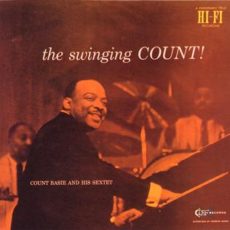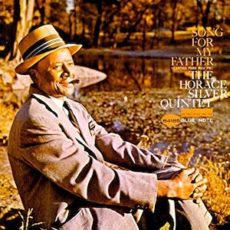
Daily Dose Of Jazz…
William James “Count” Basie was born on August 21, 1904 in Red Bank, New Jersey. His father played the mellophone, his mother played the piano and gave him his first piano lessons. Taking in laundry and baking cakes for sale for a living, she paid 25 cents a lesson for his piano instruction. The best student in school, he inished junior high school and spent much of his time at Red Bank’s Palace Theater, where he quickly learned to improvise music appropriate to the acts and the silent movies.
A natural pianist but preferring drums he was discouraged by the obvious talents of Sonny Greer, who also lived in Red Bank and became Duke Ellington’s drummer in 1919, He let the idea of drumming go and concentrated on the piano exclusively at age 15. He and Greer played together in venues until Greer set out on his professional career. By then, Basie was playing with pick-up groups for dances, resorts, and amateur shows, and Harry Richardson’s Kings of Syncopation.
By 1920 Basie was in Harlem where he bumped nto Greer and started meeting the musicians making the scene like Willie “The Lion” Smith and James P. Johnson. Before he was 20 years old, he toured extensively on the Keith and TOBA vaudeville circuits as a solo pianist, accompanist, and music director for blues singers, dancers, and comedians. This provided an early training that was to prove significant in his later career.
Back in Harlem in 1925, he met Fats Waller, who taught him how to play that instrument. As he did with Duke Ellington, Willie “the Lion” Smith helped Basie out during the lean times by arranging gigs at house-rent parties, introducing him to other leading musicians, and teaching him some piano technique.
In 1928, Basie joined Walter Page and his Famous Blue Devils. It was at this time that he picked up the moniker of Count. The next year saw him in Kansas City holding down the piano chair with Bennie Moten. After a couple of re-organizations of the band, Basie formed his own nine-piece band, Barons of Rhythm who played regularly at the Reno Club and on the radio. Moving to Chicago, Illinois the band eventually became the Count Basie Orchestra where they did their first recordings for Vocalion under the name Jones-Smith, as Basie had already signed with Decca.
Over the course of the fifty years he led the band he was instrumental in creating innovations like the use of two “split” tenor saxophones, emphasizing the rhythm section, riffing with a big band, using arrangers to broaden their sound, which any other bands copied. He also brought to prominence such players as Lester Young, Herschel Evans, Freddie Green, Buck Clayton, Harry “Sweets” Edison, Al Grey, Jimmy Rushing, Helen Humes, Thelma Carpenter, and Joe Williams.
Pianist, organist, bandleader, and composer Count Basie, who recorded close to two hundred albums and in 1958 became the first Black man to win a Grammy Award, passed away on April 26, 1984.
More Posts: bandleader,composer,instrumental,music,organ,piano

Daily Dose Of Jazz…
Jack Teagarden was born Weldon Leo Teagarden on August 20, 1905 in Vernon, Texas into a musical family, two brothers, a sister and father all musicians. His father started him on baritone horn but by age seven he had switched to trombone. His first public performances were in movie theaters, where he accompanied his mother, a pianist.
By 1920, Teagarden was playing professionally in San Antonio, Texas with the band of pianist Peck Kelley. In the mid-1920s he started traveling widely around the United States in a quick succession of different bands. 1927 saw him in New York City where he worked with several bands and by 1928 he was playing with the Ben Pollack band.
In the late 1920s, he recorded with such bandleaders and sidemen as Louis Armstrong, Benny Goodman, Bix Beiderbecke, Red Nichols, Jimmy McPartland, Mezz Mezzrow, Glenn Miller, and Eddie Condon. Miller and Teagarden collaborated to provide lyrics and a verse to Spencer Williams’ “Basin Street Blues”, which in that amended form became one of the numbers that Teagarden played until the end of his days.
Seeking financial security during the Great Depression, Jack signed an exclusive contract to play for the Paul Whiteman Orchestra from 1933 through 1938. In 1946, he joined his lifelong friend Louis Armstrong and his All Stars. In late 1951, he left to again lead his own band.
Suffering from pneumonia, trombonist and singer Jack Teagarden, considered the most innovative jazz trombone stylist of the pre-bebop era, passed away in New Orleans at the age of 58 on January 15, 1964.
More Posts: bandleader,history,instrumental,jazz,music,trombone,vocal

The Quarantined Jazz Voyager
As the pandemic wages on, rising numbers amongst the unvaccinated, the unmasked and the ignorant threaten the spread to the vaccinated and the children, while once again filling our hospitals. I cringe to think of the children who are going to be forced back to school without a vaccine. I’ve personally had a vaccinated friend who tested positive while working at a day camp with exposed children. Camp was shut down immediately, friend is fine but the Delta variant is highly contagious, like chicken pox. Be vigilant and stay safe.
With that in mind, I am pulling out the classic Song for My Father, the hard bop album by the Horace Silver Quintet, inspired by a trip that Silver made to Brazil. The songs were recorded at Van Gelder Studios in Englewood Cliffs, New Jersey by two different ensembles over two sessions ~ 3,6 on October 31, 1963 and 1,2,4,5 on October 26, 1964. Produced by Alfred Lion, it was released on the Blue Note record label in January, 1965.
The cover artwork features a photograph of Silver’s father, John Tavares Silver, to whom the title composition is dedicated. The title track, Song for My Father, is the leader’s most recognized composition, blending his native Cape Verdean folk music with bossa nova.
Track Listing | 42:12 All compositions by Horace Silver, except #5- Song for My Father ~ 7:17
- The Natives Are Restless Tonight ~ 6:09
- Calcutta Cutie ~ 8:31
- Que Pasa ~ 7:47
- The Kicker (Joe Henderson) ~ 5:26
- Lonely Woman ~ 7:02
- Horace Silver ~ piano
- Carmell Jones ~ trumpet (2, 5 solo | 1, 4 ensemble)
- Joe Henderson ~ tenor saxophone (1,2,4,5)
- Teddy Smith ~ bass (1,2,4,5)
- Roger Humphries ~ drums (1,2,4,5)
- Blue Mitchell ~ trumpet (3, ensemble)
- Junior Cook ~ tenor saxophone (3, ensemble)
- Gene Taylor ~ bass (3,6)
- Roy Brooks ~ drums (3,6)
More Posts: adventure,album,club,genius,jazz,museum,music,piano,preserving,restaurant,travel

Daily Dose Of Jazz…
Dill Jones was born Dillwyn Owen Paton Jones on August 19, 1923 in Newcastle Emlyn, Carmarthenshire, Wales. He was brought up in New Quay on the Cardiganshire coast. Music was in the family, his mother a pianist and his aunt played organ at the Methodist Tabernacle. He was exposed to jazz as a 10-year-old by hearing records by Fats Waller and Bix Beiderbecke on the radio.
After leaving college, Jones followed his father into banking but was called up by the Royal Navy for wartime service in the Far East. When the war ended he enrolled at Trinity College of Music in London, England but did not complete the course, preferring the informality of late night jazz sessions.
Joining the Harry Parry Sextet and Vic Lewis’ Orchestra before plying his trade as ship’s pianist on the luxury liner, the Queen Mary, he sailed between New York City and Southampton. This gave Dill the chance to hang out in New York’s jazz clubs and hear Coleman Hawkins and Lennie Tristano, among others. After forming the Dill Jones Quartet in 1959, he emigrated to the United States in 1961, settling in New York City. He became an expert in the Harlem stride style. was soon in demand, earning his reputation playing with the likes of Gene Krupa, Jimmy McPartland and Yank Lawson.
Between 1969–1973, Jones was a member of the JPJ Quartet with Budd Johnson, Oliver Jackson and Bill Pemberton. A double CD anthology of Dill Jones` work was released in 2004, entitled Davenport Blues – Dill Jones plays Bix, Jones and a Few Others.
Pianist Dill Jones, who was instrumental in bringing jazz to British television when he hosted the BBC Jazz Club, passed away from throat cancer in a New York hospital on June 22, 1984. He was 60

Daily Dose Of Jazz…
Zinky Cohn was born on August 18, 1908 in Oakland, California. Little is known about his childhood but it has been speculated by many Jewish historians he descended from one of the so-called 12 tribes.
Moving to Chicago, Illinois in the late 1920s, he played around town and from 1928 to 1930 was a member of Jimmie Noone’s Apex Club Orchestra. He recorded extensively with Noone between 1929 and 1934, especially for Vocalion Records. Many of the tunes Noone recorded were written and/or arranged by Cohn, including Apex Blues, previously attributed to Earl Hines.
Cohn also recorded as a leader in the early 1930s, with a band that featured Leon Washington on tenor saxophone. Cohn recorded with Frankie Franko & His Louisianans in 1930, and also accompanied blues singers such as Georgia White.
Later in the 1930s he led the Chicago musicians’ union, and continued to play locally. Pianist Zinky Cohn passed away on April 26, 1952 in Chicago.



